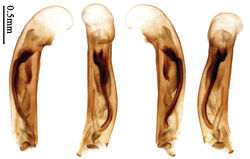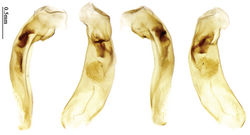Orionella
| Notice: | This page is derived from the original publication listed below, whose author(s) should always be credited. Further contributors may edit and improve the content of this page and, consequently, need to be credited as well (see page history). Any assessment of factual correctness requires a careful review of the original article as well as of subsequent contributions.
If you are uncertain whether your planned contribution is correct or not, we suggest that you use the associated discussion page instead of editing the page directly. This page should be cited as follows (rationale):
Citation formats to copy and paste
BibTeX: @article{Shi2013ZooKeys284, RIS/ Endnote: TY - JOUR Wikipedia/ Citizendium: <ref name="Shi2013ZooKeys284">{{Citation See also the citation download page at the journal. |
Ordo: Coleoptera
Familia: Carabidae
Name
Orionella Jedlička, 1963 – Wikispecies link – Pensoft Profile
- Orionella Jedlička 1963[1]: 307; Habu 1979b[2]: 64.
- Endynomena auctt. [not Chaudoir 1872[3]]: Habu 1967[4]: 131. [Synonym]
Type-species:
Orionella obenbergeri Jedlička, 1963 [= Endynomena lewisii Bates], by original designation.
Diagnosis
Dorsal side evenly pubescent, elytra with accessory setae on all intervals; mandibles strongly widened; labrum and outer scrobe of mandibles nearly glabrous; pronotum with basal foveae wide and shallow; elytral intervals slightly convex; median lobe of aedeagus slender and straight, not setose around apical orifice, apical lamella more or less bent backwards.
This genus strongly resembles Endynomena, but is not closely allied with it given the differences in the male genitalia and male secondary sexual characters. Beyond the remarkable differences in male genitalia (Figs 91–94), Orionella is distinguishable from Endynomena in having the following characters: (1) striae deeper, intervals slightly convex, striae distinct in apical half, but in Endynomena striae shallow, intervals barely convex, striae nearly effaced in apical half; (2) 7th interval without several long setae, but in Endynomena with such setae; (3) pronotal base weakly but distinctly lobed, but in Endynomena pronotal base hardly lobed; (4) tempora less swollen than in Endynomena; (5) apex of mentum tooth truncate, but always rounded in Endynomena; (6) males with adhesive hairs only present on 1st and 2nd protarsomeres, but present on 1st to 3rd protarsomeres in Endynomena.
Generic characters
Body length 8.3–9.2 mm. Dorsal side reddish brown to dark brown, elytra unicolored or bicolored, without metallic luster; body rather flat; dorsal side densely pubescent, pubescence short, not erect. Head. eyes hemispherical, strongly prominent; tempora short, half length of eyes, slightly tumid, gradually narrowed behind eyes; vertex not distinctly tumid. Antennae barely extended to elytral base. Labrum widened to apex, apical margin distinctly emarginate, with faint isodiametric microsculpture, glabrous or with a few very fine short secondary setae; mandibles distinctly widened, outer margins rounded, glabrous on outer scrobes, with some setae arranged along dorsal ridge; terminal maxillary palpomeres slender in both sexes, apices slightly truncate; terminal labial palpomeres slightly widened in both sexes, males somewhat wider, but not typical securiform, apices slightly truncate; ligula with apex slightly projected, with four setae; paraglossae membranous, not longer than ligula, slightly widened, adnate; mentum tooth widened, trapezoid, apex truncate, with two long setae at base, sometimes with a few additional short setae; submentum with two long setae; genae with long setae beneath eyes; gula nearly glabrous except apical part. Pronotum transverse, surface densely pubescent; lateral margins with setae along full length, a few long setae present at front angles, four long setae at the greatest width, primary setae on hind angles slightly longer than others; basal foveae wide and shallow; pronotal base weakly but distinctly lobed; lateral margins completely rounded in middle, more or less sinuate before hind angles; hind angles sharp or not. Elytra wide, slightly expanded to apex; apex truncate, sutural angles not projected, outer angles completely rounded; basal margination only reaching 3rd interval; basal pores large; striae shallow but distinct, indistinctly punctate; intervals slightly convex; all intervals evenly pubescent, pubescence fine and longish, not erect; primary setigerous pores small, 3rd interval with four pores, 5th interval with one pore near base; 3rd to 6th intervals slightly depressed near middle, 7th and 8th intervals slightly tumid near apex. Ventral side with dense pubescence; males with apex of terminal sternum moderately emarginate, with two pairs of setae; females with apex of terminal sternum straight, with two pairs of setae. Legs short; protibiae with cleaning spur well developed, distant from inner margin; tarsi widened, 4th tarsomere bifid, claws pectinate. Males with adhesive hairs well developed (two whole rows) on 1st and 2nd protarsomeres and apical half of 1st mesotarsomere; rudimentary (very few near apex, sometimes absent) on 2nd mesotarsomere. Male genitalia with median lobe of aedeagus slender, not twisted, nearly straight in lateral view, slightly bent to right side in dorsal view; apical orifice opened apically; apical lamella small, rounded, more or less bent backward; right surface with some fine setae subapically; internal sac with main flagellum slightly thickened, apex distant from apical orifice, trumpet-form expansion small; an elongate scaled area subparallel to main flagellum; apical bursa present; secondary flagellum present. Female genitalia. Spermatheca tubular, with ring-sculpture, inserted on bursa copulatrix; spermathecal gland much longer than spermatheca, inserted near base of spermatheca; spermatheca not distinctly bent. Apical segment of ovipositor slender and straight, apex sharp, base gradually widened, apex with membranous extension short and rounded.
Distribution
(Map 8). Japan, Korea, China, Burma, Nepal.
Monophyly and relationships. From general appearance, this genus could be allied with Lachnoderma or Dasiosoma, but genital characters suggest that it could be rather isolated within Physoderina. The monophyly of Orionella can be inferred from the following apomorphic character states: (1) median lobe of aedeagus tubular, not laterally compressed; (2) internal sac with main flagellum abruptly terminated before apical orifice; (3) apical lamella bent backward; (4) apical segment of ovipositor straight, not curved outward.
Key to species of Orionella Jedlička
Taxon Treatment
- Shi, H; Zhou, H; Liang, H; 2013: Taxonomic synopsis of the subtribe Physoderina (Coleoptera, Carabidae, Lebiini), with species revisions of eight genera ZooKeys, 284: 1-129. doi
Other References
- ↑ Jedlička A (1963) Monographie der Truncatipennen aus Ostasien, Lebiinae- Odacanthinae- Braehyninae (Coleptera, Carabidae). Entomologische Abhandlungen und Berichte aus dem Staatlichen Museum fuer Tierkunde in Dresden 28: 269-579.
- ↑ Habu A (1979b) Notes on Endynomena Chaudoir and Orionella Jedlička (Coleoptera, Carabidae). Entomological Review of Japan 33 (1/2): 61–65.
- ↑ Chaudoir B (1872) Monographie des Callidides. Annales de Societe Entomologique de Belgique 16: 97-204.
- ↑ Habu A (1967) Fauna Japonica, Carabidae Truncatipennes Group (Insecta: Coleoptera). Biogeographical Society of Japan. Japan, 338 pp.
Images
|





